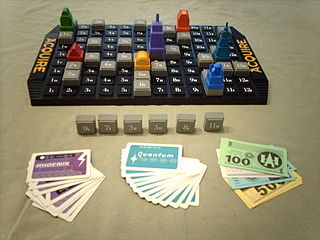
Acquire is a board game published by 3M in 1964 that involves multi-player mergers and acquisitions. It was one of the most popular games in the 3M Bookshelf games series published in the 1960s, and the only one still published in the United States.
The Mind Sports Organisation (MSO) is an association for promoting mind sports including Contract Bridge, Chess, Go, Mastermind, and Scrabble. Since 1997 it has annually organised in England a multi-sport competition, the Mind Sports Olympiad.

TwixT is a two-player strategy board game, an early entrant in the 1960s 3M bookshelf game series. It became one of the most popular and enduring games in the series. It is a connection game where players alternate turns placing pegs and links on a pegboard in an attempt to link their opposite sides. While TwixT itself is simple, the game also requires strategy, so young children can play it, but it also appeals to adults. The game has been discontinued except in Germany and Japan.
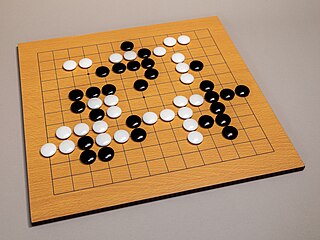
Abstract strategy games in contrast to strategy games in general usually have no or minimal narrative theme, outcomes determined only by player choice, and all players have perfect information about the game. For example, Go is a pure abstract strategy game since it fulfills all three criteria; chess and related games are nearly so but feature a recognizable theme of ancient warfare; and Stratego is borderline since it is deterministic, loosely based on 19th-century Napoleonic warfare, and features concealed information.
The GIPF Project is a series of seven abstract strategy games by designer Kris Burm.
Entropy is an abstract strategy board game for two players designed by Eric Solomon in 1977. The game is "based on the eternal conflict in the universe between order and chaos [...] One player is Order, the other Chaos. Order is trying to make patterns vertically and horizontally. Chaos is trying to prevent this." The game originally employed a 5×5 gameboard, but in 2000 a 7x7 board was introduced to allow deeper strategies.
The Decamentathlon is a multi disciplined games event that was created as part of the first Mind Sports Olympiad. It was founded to try to find the best games all-rounder in the world and hence possibly the best games player. It was given a prize fund of £10,000 for the inaugural competition, that equalled that of the highest funded event at the first MSO sponsored by Skandia. However, the other events were spread over multiple playing sessions whereas the Decamentathlon was held over just a single session. This event was initially hailed as the MSO flagship event. Although, the Mind Sports Olympiad's other new event the Pentamind has since become regarded as the more significant event despite not having a fixed format.

Bōku is an abstract strategy board game played with marbles on a perforated hexagonal board with 80 spaces. The object of the game is to arrange five marbles in a row. The game has also been sold under the name Bollox, and later Bolix and won a Mensa Select award in 1999.

Hare and Tortoise is a Eurogame designed by David Parlett in 1974 and first published by Intellect Games. In 1978 it was released by Ravensburger in Germany, and received generally positive reviews critically and won the 1979 Spiel des Jahres. It has since sold some 2 million units in at least ten languages. The current editions are published by Gibsons Games in the UK, Ravensburger in Germany and Rio Grande Games in the United States.
International Team (IT) was an Italian game company founded in the 1970s and active until the early 1980s. While the company started as a jigsaw puzzle producer, it is mostly remembered as a wargame company, a business that IT approached in 1979 after game designer Marco Donadoni joined in.
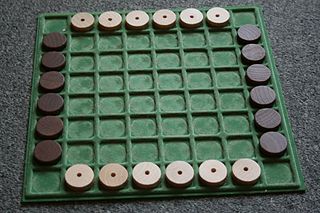
Lines of Action is an abstract strategy board game for two players invented by Claude Soucie. The objective is to connect all of one's pieces into a single group. The game was recommended by the Spiel des Jahres in 1988.
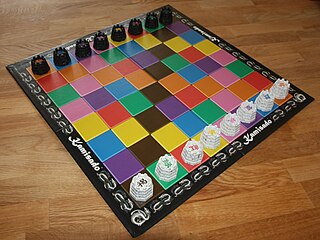
Kamisado is an abstract strategy board game for two players that's played on an 8x8 multicoloured board. Each player controls a set of eight octagonal dragon tower pieces. Each player's set of dragon towers contains a tower to match each of the colours that appear on the squares of the board. One player's towers have gold dragons mounted on the top, while the other player's towers are topped with black dragons.

The Mind Sports Olympiad (MSO) is an annual international multi-disciplined competition and festival for games of mental skill and mind sports. The inaugural event was held in 1997 in London with £100,000 prize fund and was described as possibly the biggest games festival ever held.
Gert Schnider is an Austrian professional multi-talented board-game player. In chess he is an International Master, in Go a 5th Dan, in shogi an amateur 5th Dan in Japan and 3rd Dan in Europe, and in Abalone a grandmaster.

Micro armour refers to scale models made of lead, pewter, die cast metal or plastic, usually used for wargaming purposes. Variations of the name include: mini armour, microscale, mini tanks, miniature armour, miniature tanks, micro tanks, minitanks, minifigs, armour figurines, tank figurines, etc. are also used. Micro armour is a sub-category of model military vehicle miniature figures used for military simulation, miniature wargaming, scale models, dioramas and collecting.
A deck-building game is a card game or board game where construction of a deck of cards is a main element of gameplay. Deck-building games are similar to collectible card games (CCGs) in that each player has their own deck. However, unlike CCGs, the cards are not sold in randomized packs, and the majority of the deck is built during the game, instead of before the game.
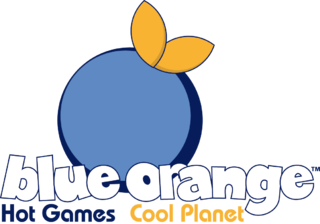
Blue Orange is a French board game company based in Pont-à-Mousson, France. Often called Blue Orange international or Blue Orange Europe and mistaken for Blue Orange Games.

Azul is an abstract strategy board game designed by Michael Kiesling and released by Plan B Games in 2017. Based on Portuguese tiles called azulejos, in Azul players collect sets of similarly colored tiles which they place on their player board. When a row is filled, one of the tiles is moved into a square pattern on the right side of the player board, where it garners points depending on where it is placed in relation to other tiles on the board.
Maureen Hiron was a British games designer and international bridge player. She is best known as a developer of over 60 board, card, dice, word and question and answer games, including the abstract strategy game Continuo. Her games were published through Hiron Games Ltd., which she founded with her husband in 1982 after retiring from teaching.












